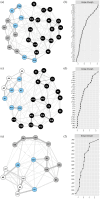Network analysis of the comorbidity between post-traumatic stress, depression and anxiety symptoms among frontline healthcare workers during the COVID-19 pandemic
- PMID: 38644941
- PMCID: PMC11032008
- DOI: 10.1177/20451253241243292
Network analysis of the comorbidity between post-traumatic stress, depression and anxiety symptoms among frontline healthcare workers during the COVID-19 pandemic
Abstract
Background: Coronavirus disease 2019 pandemic pointed out significant mental symptoms of frontline healthcare workers (HCWs).
Objective: We aimed to estimate the prevalence and comorbidity of post-traumatic stress symptoms (PTSS), depression and anxiety symptoms in HCWs from Fangcang shelter hospitals during the pandemic.
Design: Demographic information, post-traumatic stress disorder checklist for DSM-5 (PCL-5), Patient Health Questionnaire (PHQ-9) and Generalized Anxiety Disorder Questionnaire (GAD-7) were obtained online based on stratified random sampling design during April 2022, with 284 eligible responses.
Method: Hierarchical regression analyses were applied to investigate independent variables associated with psychological status outcomes (PHQ-9, GAD-7 and PCL-5), and the network analyses were applied to explore the comorbidity using all items of PCL-5, PHQ-9 and GAD-7.
Results: (1) 10.56%, 13.03% and 8.10% of HCWs reported PTSS, depression and anxiety symptoms. Fifty-three (18.66%) HCWs experienced at least one mental health disorder, among which 26.42-37.74% HCWs had comorbidity of two or three mental disorders; (2) several influence factors of mental health were identified, including medical professions, working hours, contacted patients (p < 0.05); (3) prominent bridge symptoms between PTSS and depression were sleep problems, suicide ideation, concentration difficulties and recklessness. Comorbidity between PTSS and anxiety was thought to mainly stem from negative affect, such as afraid, anxious, annoyed and worrying. Depressed mood and worry might be good targets during treatment of comorbidity of depression and anxiety.
Conclusion: Our data suggest mild level of PTSS, depression and anxiety symptoms among HCWs during the pandemic and might give novel insights into assessment and intervention of comorbidity.
Keywords: COVID-19; anxiety; depression; healthcare workers; post-traumatic stress symptoms.
© The Author(s), 2024.
Conflict of interest statement
The authors declare that there is no conflict of interest. The data that support the findings of this study are available on request from the corresponding author upon reasonable request.
Figures



Similar articles
-
The interplay between acute post-traumatic stress, depressive and anxiety symptoms on healthcare workers functioning during the COVID-19 emergency: A multicenter study comparing regions with increasing pandemic incidence.J Affect Disord. 2022 Feb 1;298(Pt A):209-216. doi: 10.1016/j.jad.2021.10.128. Epub 2021 Oct 30. J Affect Disord. 2022. PMID: 34728285 Free PMC article.
-
Work and social functioning in frontline healthcare workers during the covid-19 pandemic in Italy: role of acute post-traumatic stress, depressive and anxiety symptoms.Riv Psichiatr. 2021 Jul-Aug;56(4):189-197. doi: 10.1708/3654.36346. Riv Psichiatr. 2021. PMID: 34310576
-
Prevalence and Associated Factors of Depression and Anxiety Among Healthcare Workers During the Coronavirus Disease 2019 Pandemic: A Nationwide Study in Korea.J Korean Med Sci. 2024 Apr 8;39(13):e120. doi: 10.3346/jkms.2024.39.e120. J Korean Med Sci. 2024. PMID: 38599597 Free PMC article.
-
The psychological impact, risk factors and coping strategies to COVID-19 pandemic on healthcare workers in the sub-Saharan Africa: a narrative review of existing literature.BMC Psychol. 2022 Dec 1;10(1):284. doi: 10.1186/s40359-022-00998-z. BMC Psychol. 2022. PMID: 36457038 Free PMC article. Review.
-
Prevalence and Associated Factors of Mental Health Outcomes in Peruvian Healthcare Workers During the COVID-19 Pandemic: The FRONTLINE Study.Hisp Health Care Int. 2025 Mar 13:15404153251324638. doi: 10.1177/15404153251324638. Online ahead of print. Hisp Health Care Int. 2025. PMID: 40080850 Review.
Cited by
-
Posttraumatic stress symptoms among Chinese university students during the COVID-19 pandemic: Prevalence, correlates, and mental health help-seeking.World J Psychiatry. 2025 Jan 19;15(1):102012. doi: 10.5498/wjp.v15.i1.102012. eCollection 2025 Jan 19. World J Psychiatry. 2025. PMID: 39831004 Free PMC article.
-
Network analysis of the symptoms of posttraumatic stress disorder in patients undergoing chemotherapy for colorectal cancer.Front Psychiatry. 2025 Jan 8;15:1505518. doi: 10.3389/fpsyt.2024.1505518. eCollection 2024. Front Psychiatry. 2025. PMID: 39845359 Free PMC article.
References
-
- Borsboom D, Cramer AOJ. Network analysis: an integrative approach to the structure of psychopathology. Annu Rev Clin Psychol 2013; 9: 91–121. - PubMed
-
- Bryant RA, O’Donnell ML, Creamer M, et al.. The psychiatric sequelae of traumatic injury. Am J Psychiatry 2010; 167: 312–320. - PubMed
-
- Jones PJ, Ma R, McNally RJ. Bridge centrality: a network approach to understanding comorbidity. Multivar Behav Res 2021; 56: 353–367. - PubMed
LinkOut - more resources
Full Text Sources
Miscellaneous

